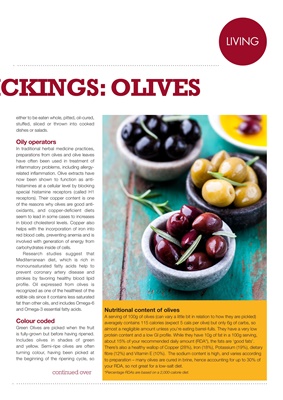
continued over
either whole, pitted, oil-cured, stuffed,
sliced or thrown into cooked dishes.
Oily operators
In traditional herbal medicine practices,
preparations from olives and olive leaves
have often been used in treatment of
inflammatory problems, including allergyrelated
inflammation. Olive extracts have
now been shown to function as antihistamines at
a cellular level by blocking
special histamine receptors (called H1
receptors). Their copper content is one
of the reasons why olives are good antioxidants, and copper-deficient
diets
seem to lead in some cases to increases
in blood cholesterol levels. Copper also
helps with the incorporation of iron into
red blood cells, preventing anemia and is
involved with generation of energy from
carbohydrates inside of cells.
Research studies suggest that
Mediterranean diet, which is rich in
monounsaturated fatty acids help to
prevent coronary artery disease and
strokes by favoring healthy blood lipid
profile. Oil expressed from olives is
recognized as one of the healthiest of the
edible oils since it contains less saturated
fat than other oils, and includes Omega-6
and Omega-3 essential fatty acids.
Colour coded
Green Olives are picked when the fruit
is fully-grown but before having ripened.
Includes olives in shades of green
and yellow. Semi-ripe olives are often
turning colour, having been picked at
the beginning of the ripening cycle, so
there are shades of red to brown on the
LIVING
Nutritional content of olives
A serving of 100g of olives (can vary a little bit in relation to how they are pickled)
averagely contains 115 calories (expect 5 cals per olive) but only 6g of carbs, so
almost a negligible amount unless you're eating barrel-fulls. They have a very low
protein content and a low GI profile. While they have 10g of fat in a 100g serving,
about 15% of your recommended daily amount (RDA*), the fats are 'good fats'.
There's also a healthy wallop of Copper (28%), Iron (18%), Potassium (19%), dietary
fibre (12%) and Vitamin E (10%). The sodium content is high, and varies according
to preparation - many olives are cured in brine, hence accounting for up to 30% of
your RDA, so not great for a low-salt diet.
*Percentage RDAs are based on a 2,000-calorie diet.
CKINGS: OLIVES